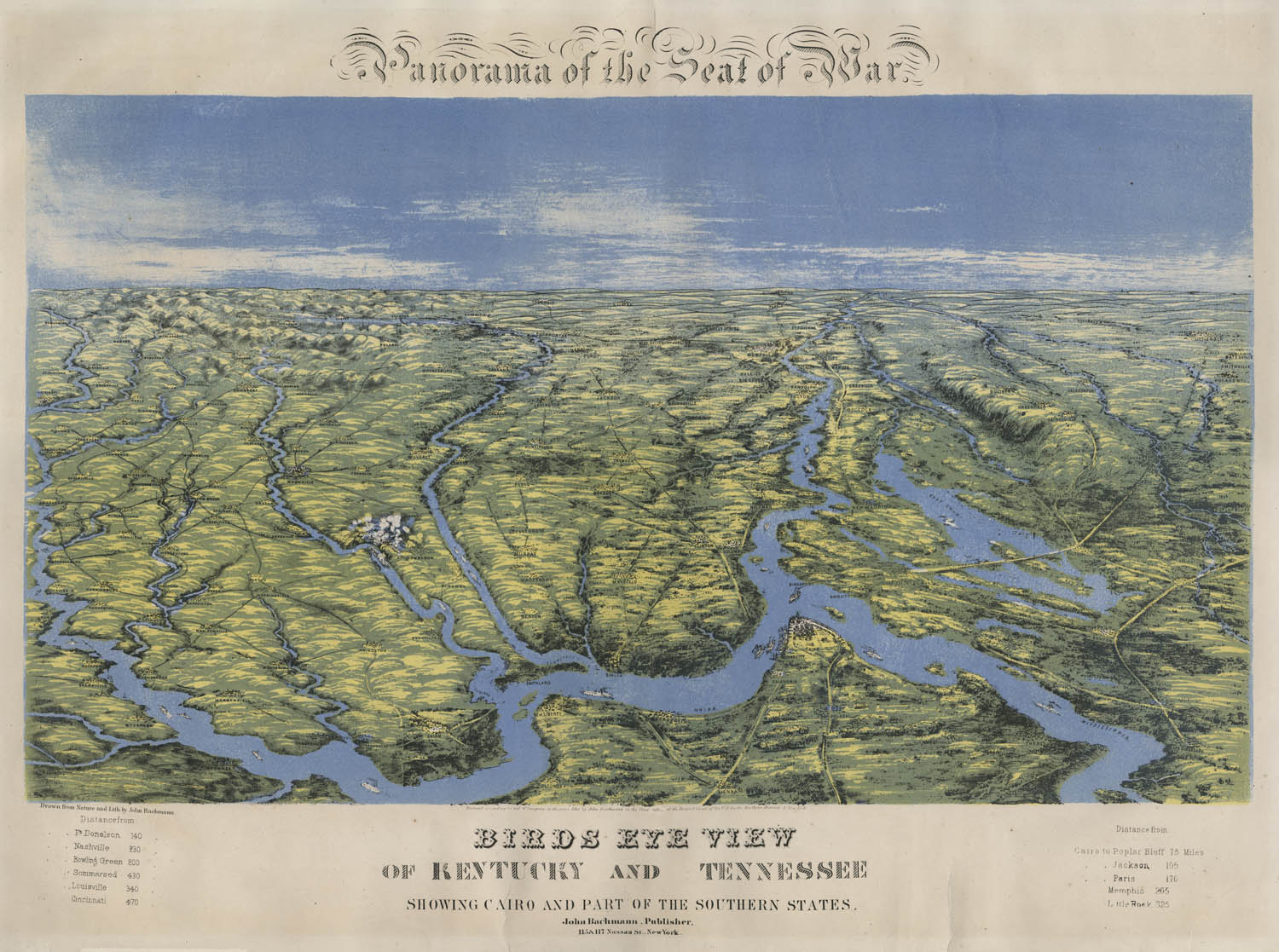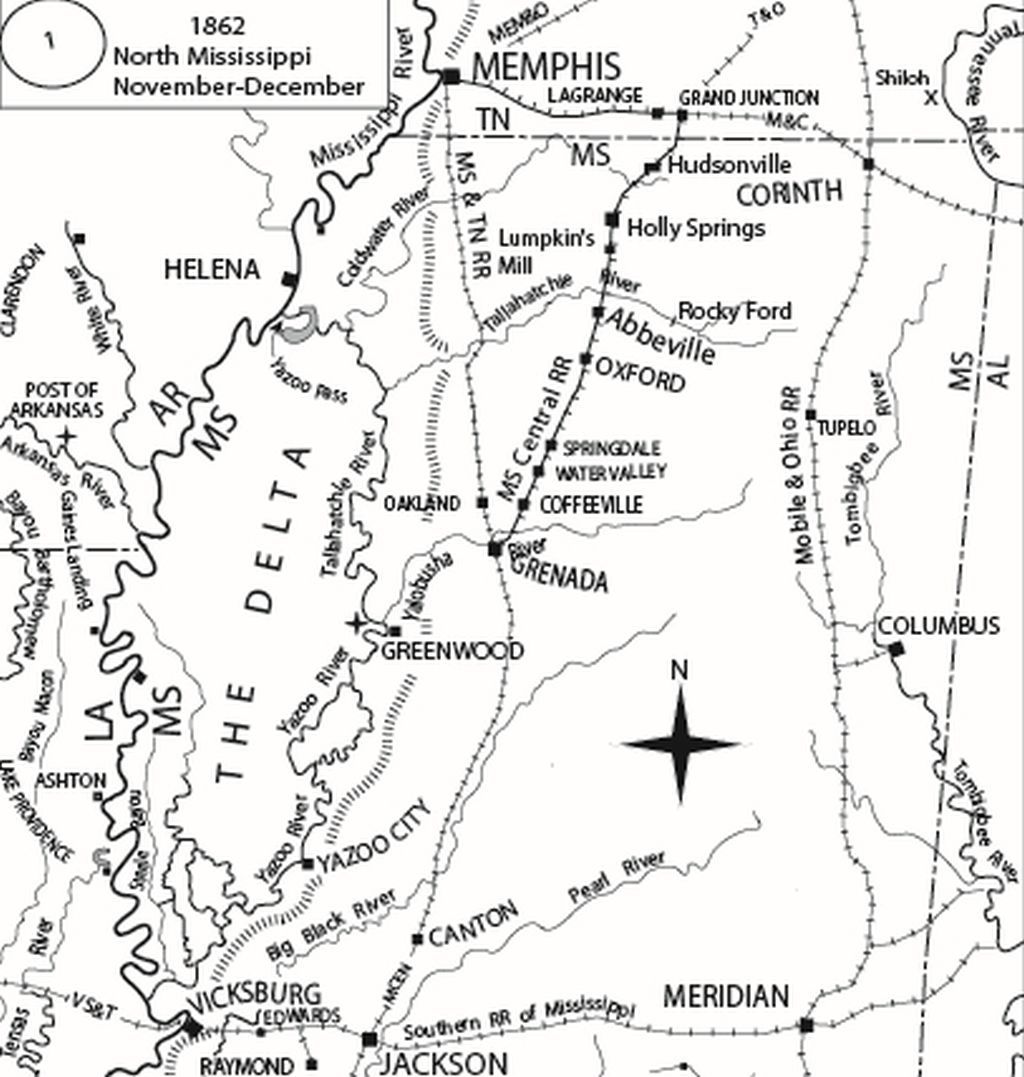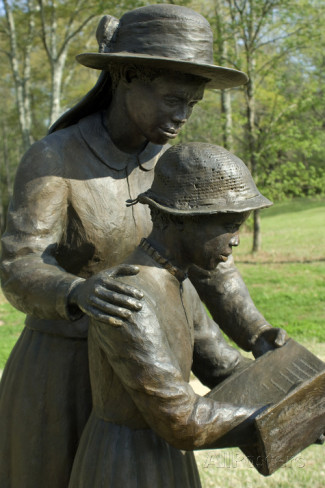
Tennessee theatre of war viewed in the general direction southward to Corinth, hidden in the distant background:
Showing the logistical complexity of that terrain
Halleck's strategy was a part of Union grand strategy, devised in Washington by Winfield-Scott. It was inherited by Grant and Sherman and percolated down the chain of command to Dodge, who would play a crucial role in its implementation. The theatre of operations in which these commanders and their Army of the Tennessee chose to implement this Union grand strategy was subjected to a more difficult and extensive topography than back East. Union Army operations from main supply bases typically in or near Illinois were fanned out through Confederate Tennessee into contiguous Southern states. And then further extended West to seize control of the Mississippi at Vicksburg, which was located at the core of the Confederacy. The difficult terrain covered therin was usually river-laced washboard.
This Western area contained pockets of mixed population base with roots on both sides of the Mason-Dixon. Their mixture was fraught with violence and was trip-wired by the fundamental causes of the War. Their mixed loyalties and local-level violence were recieving national focus way before the war started. With the breakdown of the Missouri Compromise and the national backlash from its Kansas-Nebraska Compromise replacement , there was no longer anything like a mutually ageed-on Mason-Dixon line establised to help sort out the conflict. Even beyond this, there was yet more conflict-- this involving Indians all around the periphery of Western settlments. While the latter was of a lower intensity than that dividing the settlers, its potential was nontheless always present, practically anywhere out West.
All of this meant the battles fought out West encompassed a vaster territory and were less focused geographically than those back East. Neverheless, they proved of coequal importance. To the point those in the East were even eventually fought by command transferred from the West. But even before this transfer of command, some historians make the case for Corinth in northern Mississippi becoming the strategic center of gravity for the entire war. This, around 1862.
King Cotton
The Union's overriding impetus in implementing this grand strategy was to interdict the South's cotton exports. These were crucial to the South's war effort by providing both hard currency and the tools of war to compensate for the serious shortfall in Southern domestic production and solvency due mostly to its agrarian economic base. At the start of the US Civil War, Britain especially best-served the South's war aims and efforts in multiple ways. Britain's solid industrial base in textiles was almost entirely dependent on Southern cotton. Britain was probably also the heavy industry leader in global manufacturing. As such, Britain offered a one-stop market providing the gamut of the instruments of war, their shipment, and their fincancing. Also, British sentiment at this time was open to trading with the Southern cause. Despite sentiment against slavery, powerful elements of the British polity were more concerned with brash American expansion and thus viewed the South's secession with relief.
Dodge on the Tennessee River
The Tennessee and Mississippi Rivers provided the central focus for Union strategy. But it was the railroads which provided the vital connections for campaigning to, between, and even in some cases along or as alternates to these two rivers. And there 'X'marked the spot in Corinth, which was a cross-roads junction offering rail-routes both North to South from Nashville to Mobile, as well as West to East routing from the Mississippi River through Corinth all the way to Charleston, South Carolina.
This Confederate battle flag dramatically displays the intensity
of the fighting in the Tennessee theatre around Corinth
Dodge's command at this time campaigned along the Tennessee and involved a base of command at Corinth Mississippi. Crucial as well, was maintaining communications from Nashville to Decatur Alabama. Decatur was also strategically important as a springboard for Union invasion south, to objectives in the Confederate heartland like Atlanta. Dodge developed and commanded a "Pioneer Corps" of around 5-8,000-- similar to modern-day combat engineers. These same troops would prove themselves in combat later during the siege of Atlanta. Prior to that, their current main mission was to protect Grant's flank and line of supply during his siege of Vicksburg. Such included maintaining lines of supply for Union forces in Tennessee and tying down Confederate forces by maintaining credibility in the threat moving south. This threat became more important after Vicksburg's capture and pointed the way to the siege of Atlanta. All together the Nashville-Mobile, the Columbus-Corinth railroads, along with the Tennessee and Mississippi Rivers formed a two-way and redundant supply core-grid of supporting interior communications for Union offensive initiatives in just about any direction, Atlanta included.
But, while the map of the railroads in, and around Tennessee may have looked enticing enough to describe Tennessee as the strategic center of the War, in reality these rail routes were considerably degraded from continual destruction and reconstruction by both sides. Such was to act as a proving ground for Dodge's Pioneer Corps. They were kept very busy: over one forty-day period rebuilding 182 bridges over washboard, swampy ground using just local resources.
A New Kind of Lightning War Challenges Union Mass Mobility by Railroad
This mission taken on by Dodge's command also had another dimension, coming up against some of the most capable Confederate commanders. Nathan Bedford Forrest for one, whom even Dodge had to rate as the best cavalry officer "in the rebel force". Forrest and his men were local to this area, seemingly ranging then concentrating at-will, always one step ahead of Dodge and any other Union commander.
Such tactics would also prove equally as effective for subsequent Confederate raiders, such as John Hunt Morgan. And others as well, like William Quantrill and Sterling Price, whom Dodge would also confront subsequently in Missouri later in the war. Such tactics combined light cavalry mobility with the poplar support of locals-- the latter often providing decisive effectiveness in a classic guerilla warfare scenario.
Forrest's new tactics put Union theatre tactics and strategy seriously at-risk. Union operations in the Tennessee theatre were based on using mass mobility along lines of communications, including both traditional ones like rivers and modern ones like railroads. The latter proved seriously vulnerable to Forrest's depradations. The best solution to Forrest Dodge could come up with was to guard vulnerable rights-of-way like bridges with heavily fortified guard houses. The reality proved its inadequacy. Hence the need for his Pioneer Corps to rebuild so many bridges.
Unlike the other Confederate raiders, Forrest also showed vision beyond his-own local tactics, appreciating the strategic importance of the Tennessee theatre even after the battle lines had passed by it (and him). He then asked Jefferson Davis for reinforcements, proposing to cut off Sherman's march South at the knees by interdicting his vital lines of supply through this area. Fortunately for the Union forces in the South, Davis demurred over this proposal.
Dodge as Spy Master for Grant's Detaching his Command towards Vicksburg
One of Dodge's critical assignments at this time was coordinating intelligence for the entire Army of the Tennessee
. At the root cause of Dodge's appointment by Grant was the menace of able and mobile Confederate military commanders like Forrest operating east of Grant's army on the Mississippi.
Grant was greatly concerned with his exposed position in Confederate territory west of the bulk of Union forces he had left on the Tennessee. For this reason, Grant foresaw a special role for Dodge already consistent with his railroad communication skills and beyond any part Dodge would take on in combat on the Tennessee.

Grant's base of operations on the Mississippi at Vicksburg(lower left)
vrs. Dodge 's on the Tennessee River at Corinth (upper right)
Distance approx. 300 miles
In backing Dodge's intelligence network, Grant had previously been most impressed with Dodge's knowledge on the frontier and with his acting "promptly without awaiting orders". Grant saw both qualities as "particularly fitted him" for his command. And Dodge thus "could not be spared" from his special role of coordinating all intelligence east of Grant. Dodge's use of intelligence had previously been battle-tested in Arkansas. He had provided critical intelligence which had influenced the battle's outcome to his then commander at Pea Ridge, Maj.Gen. Curtis. It was Dodge who reported an undiscovered attempt by Confederates to move in-force behind the Union battle line and to concentrate for a surprise attack. Oversight of intelligence fit in nicely as a natural extension of Dodge's railroad duties, which already gave Dodge a birds-eye perspective over all alternative routes for any significant Confederate troop movement. Dodge already had a working knowledge of telegraph communications, which usually ran along side any railroad right of way and which provided the most rapid infrastructure for communicating intelligence.
His intelligence gathering extended beyond all this to include running a network of ex-slaves who would then return behind Confederate lines to report on events of interest to the Union army. Union sympathizers(ie "scallywags") throughout the region also provided willing recruits, among them women spies. All this helped only somewhat in countering the comparative advantage Forrest and similar Confederate commanders enjoyed from waging battle throughout states offering the well-distributed support of their side by a local population which had seceeded to their cause. The network was run directly and exclusively under Dodge to maintain agent's security, with the intelligence it gathered passed onto Grant next-inline. In this way Grant was to remain continuously informed on any impact information so gathered might have on his exposed position further West. Grant tightened security over this network to the extent of even permitting Dodge to refuse any of its details to his immediate superiors or to auditors inquiring about its expenses. Dodge's spy ring grew to be the largest extant during the Civil War, comprising around 130 operatives by late 1863. It not ony covered Confederate troop movements in and along the Tennessee, but extended as far beyond as Vicksburg, Meridian, Selma, Mobile, Chattanooga, and Atlanta-- all reporting directly to Dodge in Corinth
Despite its overall success, there were times when Dodge's mix in command tasks proved hazardous to Grant's detachment to Vickburg. One got serious when it involved Forrest.
The Tennessee-Mississippi Theatre-- A Proving Ground for both Dodge and Western Command Doctrine
Several points in the above commentary bear repetition and closer examination, as they illustrate Western departure from how Union military operations back East were conducted.
Along with his approach to his own operations, Grant put great emphasis on coordinating with Dodge using a Western approach to command as a basis for both.
• According to Grant, Dodge was "particularly fitted" due to his frontier experience. As a Westerner, he was familiar with the region's way of life, and conducting his command in the midst of its self-contested, troubled areas.
• Dodge was used to doing railroading and other assignments as he had before out West, independently, with minimal support, using tools and materials at-hand.
• He knew how to improvise, acting promptly, and "without awaiting orders". These habits were judged indespensible for intelligence work in the region that Dodge did for Grant.
• All of this was foundational for anchoring Grant's shaky supply linkeage as he took the extreme risk of dividing force by extending onto the Mississippi through Confederate territory to lay seige to Vicksburg.
The overall point to be made here being: all of this further emphasizes Western differences from how someone like McClellan campaigned back East.

Statue of Freed Slave Woman Teaching a Girl
to Read at the Union Army's Contraband Camp.
Dodge's 'Contraband Camp'
The migration of ex-slave refugees to the Union lines provided the manpower for Dodge's many diverse operations. Some time before the end of 1862 this led to the formation of refugee camps, whch reached a critical enough mass for the Union command to recruit a whole regiment of African descent, called the the First Alabama Cavalry. But such camps caused controversy as well within the Union chain of higher command.
Dodge's establishment of this camp was a natural outgrowth from his gathering of intelligence through ex-slaves. However, his doing so on his own initiative and his arming of ex-slaves proved quite controversial. Slave-refugees were still considered as property and hence identified with the most unfortunate term "contraband". But at least they were no longer to be returned to their Confederate masters like Dred Scott. So, what to do? Both Grant and Sherman were concerned that establishing camps for them maybe contrary to Union policy. Grant abruptly ordered Dodge to see Lincoln, which concerned Dodge that he was about to be disciplined. Instead, to Dodge's surprise, Lincoln, forgetting about meeting Dodge previously in Council Bluffs before the War, conducted a detailed conversation exclusively on which route West was best for the Transcontinental. Subsequently, Dodge's contraband camp at Corinth was disbanded as the War's intensity moved on elsewhere.
So, why all the fuss and the disbandonement of the camp? The reason has all to do with the same issue of slavery which had entangled US policy and led to war in the first place. As far as just the Union side was concerned, its policy was no-less 'peculiar' than the institution of slavery itself and still groping to discover a clear, consistent course of direction. On Dodge's war-theatre level, the course was clear. Ex-slaves were an important human resource to be fully engaged in a theatre of war whose outcome was far from certain.
But such was far from the case for the Union national-level. And such was still not the state of affairs even after the Emancipation Proclamation..... which supposedly completely freed all the slaves? Not so! And with good reason. Even after the Proclamation, Union policy was to return refugee slaves to their masters when these resided in states loyal to the Union. The slave population for these states constituted more than 400 thousand in number!! The policy of returning slaves devolved most crucially around the border-slave states loyal to the Union which surrounded the District Capital. Hence, Union slave policy required exclusions upon which no-less than the survival of the District of Columbia depended. Even those slaves that were emancipated fell short of citizenship until the Thirteenth ammendment after the War.
The Union's Cotton Conundrum
This posed yet another challenge for Union policy to master right along side of the emancipation issue
. And Dodge with his speculation on the cotton black market, was to be found in the middle of this entangled dilemma as well. Before the war, Southern cotton exports represented no less than 70% of all U.S. exports. So, the dislocation of this trade to the South was obvious. And obvious as well therefore was the overall benefit of this enemy's deficit to Union war interests. But this trade deficit nevertheless caused inevitable major dislocations on both sides in the war.
The Union states as well, before the war were also dependant on Southern cotton. So, the Union also had to somehow make up for the cutoff in its supply. On its side, the Confederacy had its own critical needs. Of paramount importance among them, was its need for hard currency (typically gold) to purchase the needs of war globally.
Beyond all this, both sides had to deal with their war effort's expanded demand for cotton. So given this situation for both sides, all of this meant the formation of a black market in cotton was inevitable, interposing between both sides, with both belligerants trading in the same market! At least on Dodge's level, seized contraband cotton could be justified as consistent with Union policy, since he could convert it to hard currency needed for his agents in-place in the Confederacy. For Union policy makers overall however, things were not that straightforward. For one thing, Union trade accounts were severely out of balance, with 70% of its previous exports missing. As a result, this raised a massive problem over any credibility to their own financial sustainability. In a further and final complication against any clear policy, Union VIPs were scrambling to trade Southern cotton for their own private accounts. The unstoppable incentive for such activity was the profits to be made. Profits from such transactions were typically on the order of a 700% markup when their purchases were cleared into the legitimate Union cotton markets. The Lincoln administration finally gave up, ceding any control over this activity by writing it off as a necessity of the war. The irony being, this also proved good news for Confederate economic sustainability.
Overall, the lessons Dodge took from this intractable campaign and all its economic consequences went far beyond what happened to the Union (and to him) at Atlanta. Lessons-learned were even more critical to his future as a military commander and a railroad engineer in the middle of nowhere. The Union's trust in Dodge's protecting Grant's flank and their threatened lines of communications in Tennessee proved well-founded. Dodge and his Pioneer Corps had collectively pushed themselves way beyond even what they must have thought was their collective capacity. Such could only prove indispensable, even to Thomas Durant, in undertaking something on the scale of the Transcontinental railroad.